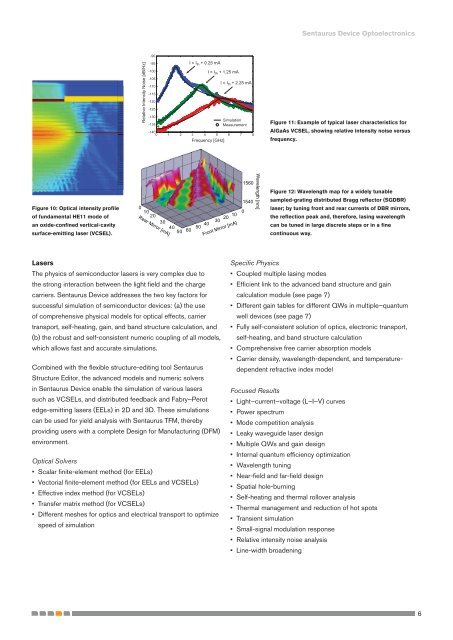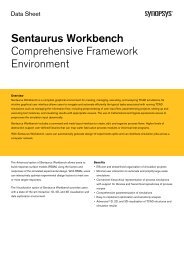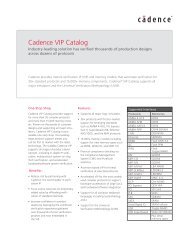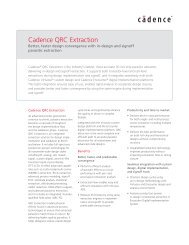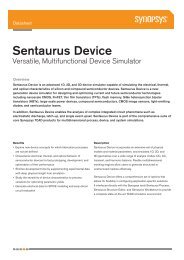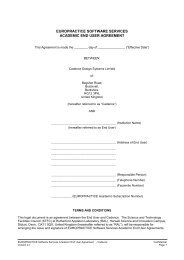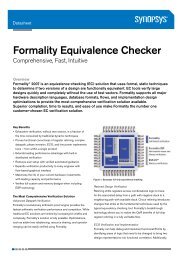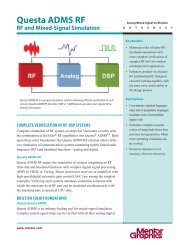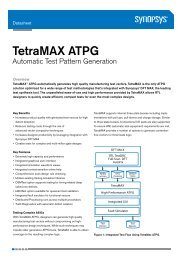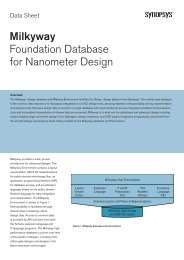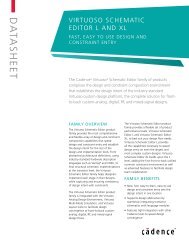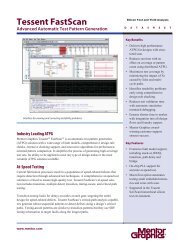Sentaurus Device Optoelectronics Datasheet - Europractice
Sentaurus Device Optoelectronics Datasheet - Europractice
Sentaurus Device Optoelectronics Datasheet - Europractice
- No tags were found...
You also want an ePaper? Increase the reach of your titles
YUMPU automatically turns print PDFs into web optimized ePapers that Google loves.
<strong>Sentaurus</strong> <strong>Device</strong> <strong>Optoelectronics</strong>Relative Intensity Noise [dB/Hz]-90-95-100-105-110-115-120-125I = I th + 0.25 mAI = I th + 1.25 mAI = I th + 2.25 mA-130Simulation-135Measurement-1400 1 2 3 4 5 6 7 8Frequency [GHz]Figure 11: Example of typical laser characteristics forAlGaAs VCSEL, showing relative intensity noise versusfrequency.Figure 10: Optical intensity profileof fundamental HE11 mode ofan oxide-confined vertical-cavitysurface-emitting laser (VCSEL).0102030Rear Mirror [mA]4050601020304050Front Mirror [mA]156015400Wavelength [nm]Figure 12: Wavelength map for a widely tunablesampled-grating distributed Bragg reflector (SGDBR)laser; by tuning front and rear currents of DBR mirrors,the reflection peak and, therefore, lasing wavelengthcan be tuned in large discrete steps or in a finecontinuous way.LasersThe physics of semiconductor lasers is very complex due tothe strong interaction between the light field and the chargecarriers. <strong>Sentaurus</strong> <strong>Device</strong> addresses the two key factors forsuccessful simulation of semiconductor devices: (a) the useof comprehensive physical models for optical effects, carriertransport, self-heating, gain, and band structure calculation, and(b) the robust and self-consistent numeric coupling of all models,which allows fast and accurate simulations.Combined with the flexible structure-editing tool <strong>Sentaurus</strong>Structure Editor, the advanced models and numeric solversin <strong>Sentaurus</strong> <strong>Device</strong> enable the simulation of various laserssuch as VCSELs, and distributed feedback and Fabry–Perotedge-emitting lasers (EELs) in 2D and 3D. These simulationscan be used for yield analysis with <strong>Sentaurus</strong> TFM, therebyproviding users with a complete Design for Manufacturing (DFM)environment.Optical Solvers• Scalar finite-element method (for EELs)• Vectorial finite-element method (for EELs and VCSELs)• Effective index method (for VCSELs)• Transfer matrix method (for VCSELs)• Different meshes for optics and electrical transport to optimizespeed of simulationSpecific Physics• Coupled multiple lasing modes• Efficient link to the advanced band structure and gaincalculation module (see page 7)• Different gain tables for different QWs in multiple–quantumwell devices (see page 7)• Fully self-consistent solution of optics, electronic transport,self-heating, and band structure calculation• Comprehensive free carrier absorption models• Carrier density, wavelength-dependent, and temperaturedependentrefractive index modelFocused Results• Light–current–voltage (L–I–V) curves• Power spectrum• Mode competition analysis• Leaky waveguide laser design• Multiple QWs and gain design• Internal quantum efficiency optimization• Wavelength tuning• Near-field and far-field design• Spatial hole-burning• Self-heating and thermal rollover analysis• Thermal management and reduction of hot spots• Transient simulation• Small-signal modulation response• Relative intensity noise analysis• Line-width broadening06-14355_sdeviceopto_ds.indd 68/31/2006 10:43:17 AM


